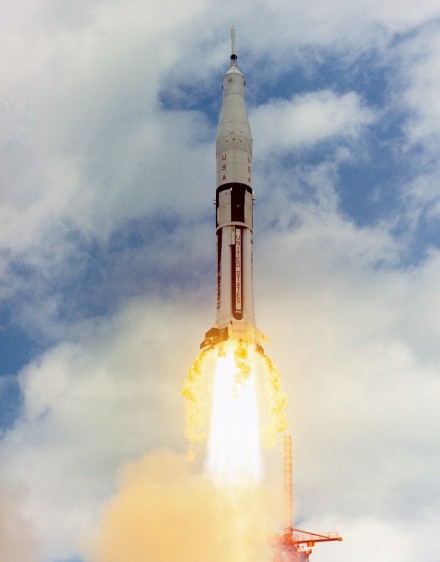Forty-six years ago this month, the United States successfully conducted a crucial suborbital flight test of the Apollo Command-Service Module (CSM). Known as AS-202, the unmanned space mission was the third involving the Apollo Block I spacecraft and the Saturn IB booster.
The primary goal of Apollo-Saturn Mission 202 (AS-202) was to man-rate the Apollo CSM for spaceflight. Accomplishment of such represented a key step along the way in America’s quest to land men on the Moon before the end of the 1960’s.
The Apollo Guidance and Navigation system flew for the first time on AS-202, as did the fuel cell system the spacecraft would use for electrical power in space. Other critcal systems tested during the mission included the Service Propulsion System (SPS) and Thermal Protection System (TPS).
Weighing 44,294 lbs, the AS-202 CSM was launched into a suborbital flight path by a Saturn IB launch vehicle. Lift-off from Cape Canaveral’s LC-34 occurred at 17:15:32 UTC on Thursday, 25 August 1966. The entire launch stack tipped the scales at a little over 1.344 million pounds at launch.
Riding on 1.6 million lbs of first stage thrust, the CSM reached an altitude of 30.2 nm in 150 seconds. During first stage flight, the Saturn IB’s eight (8) Rocketdyne H-1 engines burned 880,500 lbs of propellants (RP-1 and LOX).
Following first stage separation, the Saturn IVB upper stage then drove the CSM to an altitude of 117 nm in a 450-second burn of its single Rocketdyne J-2 engine. In doing so, this powerplant consumed 228,500 lbs of propellants (LH2 and LOX) at a thrust level of 200,000 lbs.
Shortly after second stage separation, the Apollo CSM SPS was fired for 215 seconds in the first of four (4) separate burns. This resulted in the CSM achieving an apogee of 617 nm. The total energy added by the SPS resulted in the Apollo Command Module (CM) hitting atmospheric interface (400 KFT) in excess of 29,000 feet per second.
The CM reentry trajectory featured a pull-up maneuver executed at 216 KFT. This caused the vehicle to ascend to 266 KFT and scrub-off about 4,200 feet per second in velocity. The CM then resumed a normal reentry characterized by continuing loss of altitude and velocity. By parachute deployment at 24 KFT, the vehicle base heat shield had been subjected to a thermal load of 22,900 BTU’s per square foot.
Splashdown of the AS-202 CM occurred in the north Pacific Ocean at 18:48:34 UTC. The vehicle had flown 13,900 nm downrange of Cape Canaveral and spent 93 minutes and 2 seconds in flight. Because the landing point was 200 nm off-target, the recovery ship (USS Hornet) did not arrive on station for another 8.5 hours.
The flight of AS-202 was extremely successful. So much so, that NASA declared the Apollo Block I Command-Service Module ready to fly men into space. At this point, things looked very good for the Apollo Lunar Landing Program. Sadly, the events of Friday, 27 January 1967 would profoundly affect the lives of a trio of astronauts scheduled to make the first manned flight of an Apollo Block I CSM.



Comments
I have a collection of Block 1 hardware from the Apollo program. I have a complete set of all 10 Power and Servo Trays that are stamped ” Floght 202″ the stamps aer on the trays and on every PSA module in the trays. I also have 6 Block 1 Rope Memory Modules. I have been in contact with the curator of the museum on the USS Hornet who has supplied me with interior views of the ” Flight 202 ” command module. All of the PSA trays are missing as is the AGC which would have contained the Rope Memories. Is there any record of what happened to the hardware removed from the CM. I also have 5 Rope Memory Modules Stamped ” Flight 501″ ( Apollo 4 “) Any help with my question would be appreciated or contact with any associated with either flight. I was involved on the first man rating of LTA8
Thanks,
Jim
Share this post:
I was the Electronic Crew Chief on NASA 432 (old 232) operated by Bendix Radio Flight Operations for NASA operating out of Friendship Int. Airport, Balto., MD. (now BWI)
The aircraft was modified and equipped with an S-Band telemetry receiving and recording system. The Aircraft’s cargo door in the rear was replaced with a S-Band hand steerable dish that was interconnected to the A/C autopilot such that the motion of the dish away from bore sight, changed the A/C attitude to keep the dish looking out of the center of the door, as the re-entry vehicle as it passed by on re-entry. We flew out of New Guniea and were airborne on station when As-202 began reentry. We recorded the AS- 202 reentry data. The few seconds of data gave NASA the information to determine why the vehicle missed the splashdown area by 200 NM and make corrections to the flight characteristics.
Share this post: